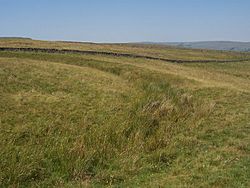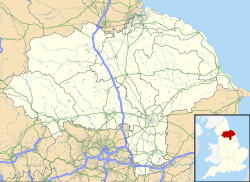Castle Dykes Henge facts for kids
Quick facts for kids Castle Dykes Henge |
|
|---|---|
| North Yorkshire, England, UK | |

Castle Dykes Henge
|
|
|
Location in North Yorkshire
|
|
| Coordinates | 54°16′52″N 2°01′43″W / 54.281245°N 2.028721°W |
Castle Dykes Henge is an amazing ancient monument in North Yorkshire, England. It's found inside the beautiful Yorkshire Dales National Park. This special place is a type of earthwork from the Neolithic period. The Neolithic period is also known as the New Stone Age. It was a time when people started farming and building large monuments.
This henge is a big, almost perfectly round shape. It has a bank of earth that is about 80 meters (or 87 yards) across. Inside this bank, there is a ditch. It's a fascinating example of what people built thousands of years ago!
What is a Henge?
A henge is a special type of ancient monument. It was built a very long time ago, often during the Neolithic period. Most henges are round or oval. They usually have a bank of earth on the outside and a ditch on the inside. Sometimes, they have the ditch on the outside and the bank on the inside.
Archaeologists believe henges were used for important ceremonies. These might have been religious events or gatherings for the community. They are not usually places where people lived. Instead, they were special sites for rituals and meetings.
Where is Castle Dykes Henge?
Castle Dykes Henge is located in the northern part of England. You can find it in North Yorkshire, a county known for its stunning countryside. It sits between two small villages called Aysgarth and Thornton Rust.
The henge is part of the Yorkshire Dales National Park. This park is famous for its rolling hills, green valleys, and historic sites. Being in a national park helps protect this ancient monument. It also makes it a great place for visitors to explore and learn about history.
Exploring Castle Dykes Henge Today
People have been interested in Castle Dykes Henge for a long time. Records show that some digging, called an excavation, happened there in 1908. Excavations are careful digs that archaeologists do to find old objects and learn about the past. However, it seems that most of the henge is still in its original state. This means it hasn't been changed much by people digging.
More recently, in 2015, a group called the Royal Archaeological Institute gave money for new research. They wanted to study the site more closely. This included doing a survey, which is like mapping out the area. They also took samples to learn about the ancient environment. This is called palaeoenvironmental sampling. It helps scientists understand what the area was like thousands of years ago, including what plants grew there.
Studying sites like Castle Dykes Henge helps us understand how people lived in the New Stone Age. It gives us clues about their beliefs, their communities, and how they used the land.


